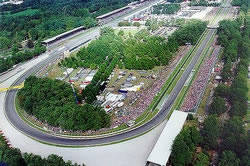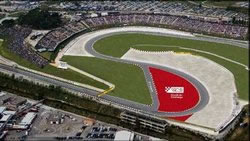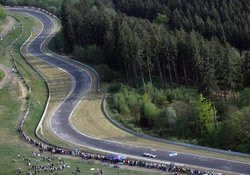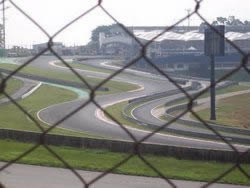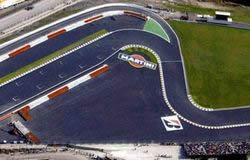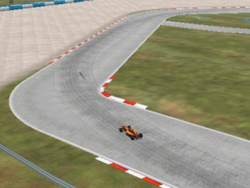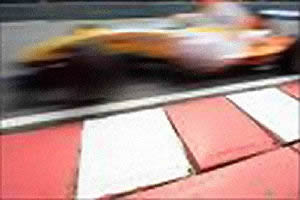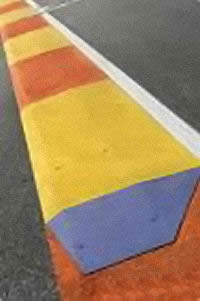Corners and cornering
To know more, check my cornering technique article.
We will try to understand why a heavier car corners slower but aerodynamic downforce (Pressure between tire and tarmac) helps a car corner faster.
Consider a racing car that drives through a corner, for simplicity, a circle. Let the letter V stands for the velocity of the car, let R be the radius of the circle and m symbolizes the mass (weight) of the car. Sir Isaac Newton (1642-1727), a British philosopher and mathematician, is famous as the discoverer of gravity. The popular story is that he was napping under an apple tree and, when wakened by a hit on the head from a falling apple, came up with the realization that there must be a force on the apple that made it fall toward the ground and clunk him on the head. Silly story or not, Newton formulated some basic relationships between mass and forces and the acceleration of bodies that are the foundation of all the engineering sciences. Isaac Newton is to engineering what Albert Einstein is to physics. Old Isaac Newton showed that if an object turns in a circle, it must be subjected to a force pointing to the centre of the circle (if there was no centre force the direction of car would be a straight line). Denote the centre force Fc. This central force is given by:

On a racing car this force is of course provided from the tires. The side force that a tire can deliver depends on the tire compound and construction and on how hard it is pressed against the ground. An approximate equation for the maximum frictional force is:
![]()
In this equation the symbol m stands for the friction coefficient between tiers and the ground and N is the normal force on the tiers; how hard they are pushed against the ground. In the mathematical language, tires with high grip have a high value of m.
Newton made the extraordinary observation that a body at rest (motionless) will remain at rest unless some force acts upon that body. That's Newton's First Law of Motion. His Second Law of Motion says that a body will accelerate when acted on by a force. The acceleration is larger if the force is larger and smaller if the mass of the body is bigger. The Second Law of Motion is represented by the equation:
![]()
which reads F equals M times A. F is the force, M is the mass of the body, and A is the acceleration of the body caused by the force.
But we're interested in racecars and in addition to accelerating in a straight line they turn corners. Race tires generate lateral forces which cause the car to accelerate toward the center of the arc of the turn. If the mass (M) is going on a circular arc, we can express A as the square of the speed (V2) divided by the radius of the curve. The equation for Newton's Second Law now looks like this:
![]()
The force, Fc, is popularly called the centrifugal force. It's what keeps the string tight when you swing a weight on a string. The force on the string goes up the faster you spin the weight and goes down as you make the string longer. The weight of the car is just like the weight on the string and the tires on a cornering car are the string!
Look at this equation, Fc=MV2/R, and think about a car going around a corner. If M gets bigger, Fc has to be bigger so that the equals sign is still right. That means the heavier the car, the more force it takes to hold the car in the arc. The faster the car, the bigger V gets and, at the same time, Fc gets larger for the same arc. A tighter corner means a lower value for R, which means Fc has to be bigger.
This is just a basic equation for what you already know. A lighter car corners faster and a smaller arc (tight turn) is a slower corner. You also know it takes more force to corner faster-you can feel it. Notice that cornering force is proportional to the square of the speed. For the same arc, cornering at 60 kmh takes four times the force as 30 kmh (60 times 60 =3,600 which is four times 30 times 30 or 900).
These few equations are all what modern racing is all about. F=MxA or its arc equivalent, Fc=MxV2/R, tells you we need a light car with a powerful engine.
Ffric = mxN says you need sticky tires, good suspension (to keep the tires in constant contact with the road), and all the downforce you can generate.
Corner phases and types
Every corner has three distinct phases: corner entry, corner apex, and corner exit. It's vital to recognize each phase per corner when describing the cars handling characteristics through that corner.
Corner Entry or turn-in is the point at which the car begins turn-in. Turn-in is, like it sounds, the broad term given to pointing the car into the corner. Braking usually, but not always, precedes this phase. Sometimes, braking is actually continued into this phase and in specific cases, carried through to the following phase. During this phase, weight begins being transferred from the inside tires to the outside tires and because of braking from rear to front tires, encourages oversteer during this phase, which the some drivers will use to help make the turn. If braking happens during this phase, the weight transfer is actually more concentrated across a diagonal from the inside rear tire to the outside front tire.
During the Corner Apex phase or 'clipping' point, the car has reached the mid-point that separates corner entry and corner exit. The apex is the corner's neutral point, the place where the transition between entry and exit is made. This phase can be very brief, in the case of a quick kink or chicane or rather extended as is the case in long constant radius corners such as Curve 2 at Brazils' Interlagos circuit or Turn 13 at the Indianapolis Motor Speedway. During this phase, weight transfer stays relatively steady from front to rear, and is concentrated to the outside tires. Corner apex is the slowest part of a corner. Different corners may have different natural apexes, whether early or late (before or after the mid-point of the corner), and individual drivers may also use different apexes according to their personal technique. (A late apex can allow power to be applied earlier and can help to 'straighten out' the corner).
Corner Exit begins at the point that steering input is begins to be decreased as the driver unwinds the wheel. This phase is where the driver will blend the throttle back in as the steering is progressively wound off: ideally keeping the car right on the edge of the traction circle through an acute sense of balance. Acceleration is usually, but no always involved in this phase. During this phase, weight transfer begins its restoration back towards the cars center of gravity be unloading off from the outside tires. The more acceleration is involved, the more this transfer shifts towards the rear and again a diagonal may be drawn from outside front to inside rear. This occurs until the cars forward travel straightens and the weight equals out to both rears.
Corner types
I want to list here only some of most frequent corner types. There is many more of them, and combos of them, but when you want setup to be done properly, you will concentrate on this few basic and most demanding types. By the way, maybe you want to check up my article about setup's of racing car. There you can learn how to setup car for every type of corner listed here.
Constant radius corner, "Parabolica", Monza |
|
|||
An increasing radius corner is one that features a longer corner exit than corner entry, and is usually accompanied by a small corner apex. In this type of corner, the idea is to brake late and turn in sharp, advancing the corner apex early, then quickly and progressively accelerate for |
Increasing radius corner, "La Caixa Corner", Circuit de Catalunya |
|||
Decreasing radius corner, Magny-Cours, "180 Degrees" |
|
|||
A fast esse is typically a combination of two or more corners. At these speeds, aerodynamic balance is a key factor. But probably equally important is the correct line which allows the fastest cumulative sector time. Missing the best line during a phase by just a meter can cost massive time loss as it disrupts the flow for the next phase, or worse yet, the entire following corner. For this reason, frontend steering response is crucial. One also driver must have faith in setup as the speeds traveled here repay mistakes with big spins. |
Fast speed esse's, Nurburgring Nordschleife |
|||
Medium speed esse's, SaoPaolo Brasil," S do Sena" |
Like a fast esse, the medium-speed esse is typically a combination of two or more corners. Here, however the springs and dampers are more important than aerodynamics, mainly due to the fact that the car is either increasing or decreasing speed as it traverses these corners. Also a more aggressive driver might use the kerbs here, so damper fast settings become a factor as well. |
|||
Chicanes are essentially slow esses, so all of the medium esse characteristics apply here. Also, because the phases happen in rapid succession (do to the overall smaller size of the chicane), car imbalances tend to be magnified at the point of weight shift during the change of direction. Also, the overall slower speeds mean aerodynamics is less of a factor in car balance and mechanical grip has a great deal of influence. Due to the tight nature of most chicanes, riding over kerbs is an acceptable risk. Many times, a chicane will be the slowest corner on a particular circuit. This means it is many times preceded by a heavy braking zone, making it a great point to fine-tuning the braking bias. As this makes the chicane a prime overtaking location, focus should be given to car setup through the preceding corner as to allow the most efficient exit. This will, in turn give the car maximum speed on the previous straight leading to the chicane, making overtaking much easier. |
Chicane, Spa Frankorschamps, Belgium," Bus stop chicane" |
|||
Hairpin Magny Cours "Adelaide corner" |
Hairpin corners stress the cars braking capabilities to their maximum. Typically, the car is being coaxed into slowing from top speed down to anywhere from 60kmh to 100kmh. Good front-end grip is essential to allow a driver to be competitive here, particularly when passing. The turn-in comes early and the short apex is at the middle of the inside kerb. While qualifying the line will vary. The braking will be kept to as late as possible (allowing the car to travel at top speed a few hundredths on a second longer), followed by a late turn-in. This will shift the apex back later in the turn (the skid marks represent a good fast line). By moving the apex later, the radius of the exit is lessened, allowing power to be applied sooner and more importantly, at a more aggressive rate. |
|||
From time to time, two successive corners will line up in such a way that it enables a driver to attack them both as a single corner. This means the first corners' exit (phase 3) and the second corners' entry (phase 1) become essentially both corners phase 2, or the overall corner apex. In this instance, the 2nd phase is rather large and may contain some throttle adjustments. The car must be set to allow mid-corner throttle adjustments to not effect the car in a negative way. Because of these things, these types of corners have the same characteristics of the constant radius corner. |
Double apex corner, Sepang, turns 7 & 8 |
|||
Apex
The middle point of the inside line around a corner at which drivers aim their cars. At this point the car comes closest to the inside edge of the track. On that point driver stop entering and start exiting the corner. That is considered to be the ideal racing line.
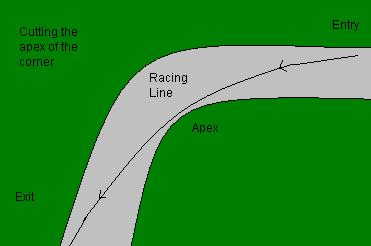
On-Camber and Off-Camber corner
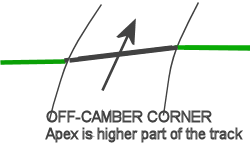 |
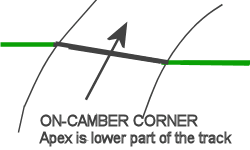 |
To visualize track camber, think of an oval racing track with banking towards the inside of the track to aid in cornering. An opposite track angle, away from the inside radius of the corner, is known as “off-camber” or "adverse camber". Part of what engineers and drivers take note of on track walks during setup day is to identify which corners are off-camber and how much so. Few of Abu Dhabi Yas Marina track corners are off-camber corners and banked corners like most of American speedway track corners are example of on-camber corners.
Monaco Grand Hotel Hairpin |
 |
Kerbs
Raised kerbstones lining corners or chicanes on racing tracks. The kerbs provide additional safety as the drivers must reduce their speed when driving over them.
|
|
|
Cornering is vital to the business of racing cars, and Formula One is no exception.
The most important is to understand 'traction circle.' The tires of a racing car have only a finite amount of grip to deliver. This can be the longitudinal grip of braking and acceleration, the lateral grip of cornering or - most likely in bends - a combination of the two.
Racing drivers overlap the different phases of braking, turning and applying power to try and make the tire work as hard as possible for as long as possible. It's the skilful exploitation of this overlap, releasing the brakes and feeding in the throttle to just the right degree not to overdo available grip, which is making the best use of the 'traction circle'. The very best are those who can extract the maximum amount from the tires for as long as possible.
Oversteer and understeer are vital to understanding the way a car corners.
Understeer is inherently stable - once the car reduces speed sufficiently grip will be restored, which is why almost all road cars are set up to understeer at the limit of adhesion. But it also slows down a car, which is why Formula One chassis engineers try to avoid it. Oversteer is, by contrast, highly unstable. Unless a driver acts to correct it quickly with skilful use of steering and throttle it can result in a spin. But an 'oversteery' chassis helps the driver to turn into a corner and, at the limit of adhesion, it enables a skilled driver to carry far more speed through a corner than understeer. Which is why, to a greater or lesser extent, all Formula One cars are set up with an oversteer characteristic.
The naming of corners on racetracks is something that's handled differently on many circuits. At Catalunya and the Nurburgring the corners are named after sponsors, at Magny Cours they're named after other circuits and at many other circuits they're named after locations that were already there before the circuit was. Albert Park in Canada is one of the circuits that has named most corners after drivers, in this case, retired multiple World Champions.
A quick scan of some circuits gives the following drivers after who corners have been named:
Ayrton Senna - 3 (Interlagos, Montreal, Hockenheim)
Alberto Ascari - 2 (Albert Park, Monza)
Niki Lauda - 1 (Albert Park)
Jim Clark - 2 (Albert Park, Hockenheim)
Jack Brabham - 1 (Albert Park)
Alan Jones - 1 (Albert Park)
Graham Hill - 1 (Albert Park)
Jackie Stewart - 1 (Albert Park)
Alain Prost - 1 (Albert Park)
Gilles Villeneuve - 1 (Imola)
Michael Schumacher - 1 (Nurburgring)
Michael Schumacher - 1 (Bahrain International Circuit) (in 2014, after his accident, to honour him and the input he gave in the construction of the circuit).
Check out article "Mosley's Equation"
To have a complete picture of performance driving, take a look at Corners, Setup, Traction circle, Using tires, Left foot braking, braking, advanced braking, WRC braking technique, Slipstreaming, drifting, cornering, shifting, Heel and toe driving technique and steering technique articles

